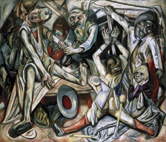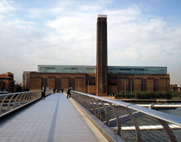-
-
Max
Beckmann is widely acknowledged as one of Germanyís leading
twentieth-century artists. A figurative painter throughout his career,
Beckmann depicted the world around him with an unparalleled intensity.
His work emerges directly from his experiences of the First and Second
World Wars, the political upheavals of the 1920s and 1930s, the rise of
Nazism, exile in Amsterdam and his final emigration to the United
States. By capturing the objects and events that surrounded him,
Beckmann hoped to grasp the deeper mysteries underlying human existence.
He perceived and painted the world as a vast stage, at once real and
magical, upon which his own life and the traumas of contemporary history
were closely intertwined.
Beckmann continuously engaged with new artistic developments and was
eager to compete with his peers. However, he refused to join any
movement or group, cultivating the image of an isolated figure within
the history of modern art. Nevertheless, his work after the First World
War had strong affinities with German Expressionism and Cubism. During
the 1920s Beckmann was regarded as a forerunner of New Objectivity (Neue
Sachlichkeit), and a decade later incorporated abstract elements in his
paintings. His ability to respond to artistic challenges ensured the
continuing vitality of his art.
This retrospective provides a largely chronological overview of
Beckmannís artistic career. It focuses on three pivotal periods:
1918-23, 1927-32 and the late 1930s into the 1940s. The first period
reflects the impact of the First World War, during which Beckmann served
as a medical orderly. By contrast, the second period is colored by
prosperity and public recognition. The final period is once again marked
by the experience of war. Under the Nazi regime Beckmann was classified
as aĎ degenerateí artist and fled to Amsterdam in 1937. Even though this
was a time of privation, isolation and anxiety, it was one of Beckmannís
most productive periods. The exhibition ends with Beckmann in America,
where, in the last three years of his life, he once again achieved
widespread recognition as a major force in modern art.
|
-
This exhibition is a collaboration between
Tate Modern, London, The Museum of Modern Art New York and Musťe
Georges Pornpidou, Paris.The London presentation was curated by Sean Rainbird, Senior Curator
Tate. Text by Susanne Bieber, Assistant Curator Tate Modern.
Tate Modern
Tate Modern is Britainís national museum of modern art. Tate Modern
displays the National Collection of international modern art from 1900
to the present, which includes major works by Dali, Picasso, Matisse and
Warhol as well as work by contemporary artists such as Sarah Lucas, Mona
Hatoum and Anselm Kiefer. Housed in the former Bankside Power Station in
Southwark, London, Tate Modern opened on 11 May 2000 and welcomes some 3
million visitors per year.
Tate Modern History
In December 1992, the Tate Trustees announced their intention to
separate the display of the Tate Collection in London between two sites.
The original Millbank gallery would show British art from 1500 to the
present day, while a new national gallery of international modern and
contemporary art would be created at a separate site.
In 1994, the Trustees acquired an option on Bankside Power Station in
Southwark, designed by Sir Giles Gilberts Scott who was also the
architect of Battersea Power Station, the Liverpool Anglican cathedral
and the famous British red telephone box. Support for the £134 million
project was provided by the Millennium Commission, the London Borough of
Southwark, the Arts Council and English Partnerships as well as by
charitable funds, private companies and individuals.
In 1995 the leading Swiss architects Herzog & de Meuron were appointed
to transform the power station into a gallery. Construction began in
autumn 1997 and by the end of 1998 seven new floors had been built
including 14,000 square metres of exhibition space and a two-storey
glass light beamí with spectacular views north and south.
Collection Displays and Exhibitions
The collection is displayed thematically in four suites that explore how
the traditional genres of art - still life, the nude, landscape and
history painting have evolved through the modern era. The themes link
historic works with contemporary, and combine painting and sculpture
with film, video, photography and installation. Rooms examining art
historical themes are interspersed with rooms devoted to a single
artist.
Tate Modernís programme of temporary exhibitions and special displays
brings works from all over the world to the gallery. Some are major
retrospectives, others explore particular themes or introduce lesser
known artists. The two exhibition suites on Level 4 provide space for
around five temporary exhibitions each year in a self-contained area
with a dedicated exhibition bookshop and expresso bar. The former
Turbine Hall provides a huge showcase for the annual sculpture
commission in The Unilever Series.
|



